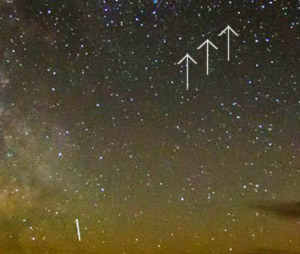Randy Halverson is an astrophotographer who takes gorgeous pictures of the sky and puts them together into amazing time lapse videos (see Related Posts below for links to his work). On Google+ this morning he posted a picture he took last night, and it’s simply stunning: the International Space Station rising into the Milky Way, with both reflected on a lake’s still waters:
[Click to embiggen.]
What a fantastic shot! I’ve tried getting similar pictures, but never managed to get one as nice as this. It takes dark skies; Randy was about 300 km west of Sioux Falls, South Dakota when he took it, where there’s almost no light pollution. The Milky Way is obvious; you can see the bulge of the central region of the galaxy, and the disk tapering off to the top of the frame. Pictures like this are always a good reminder that we live in the mid-plane of a big spiral galaxy.
When Randy got this shot the ISS was rising over the southwestern horizon. 100 meters across, 380 km up, and moving at 8 km/sec, the station reflects a lot of sunlight and moves rapidly enough to create a bright streak in short time exposures… and bright enough to create a strong reflection in the water.
A funny thing: as I looked over the picture, I saw a faint streak not too far from the ISS. You can see it in the picture I’ve included here; I’ve increased the brightness and contrast to make it more obvious, and point it out with arrows.  Given how faint it was, and the direction of the streak, I guessed it was a polar-orbiting satellite – most satellites orbit roughly west-east around the Earth, but many orbit north/south. These are usually satellites that survey the Earth for one reason or another; they point down, toward the ground, and can observe the whole planet over a few orbits as the Earth rotates underneath them.
Given how faint it was, and the direction of the streak, I guessed it was a polar-orbiting satellite – most satellites orbit roughly west-east around the Earth, but many orbit north/south. These are usually satellites that survey the Earth for one reason or another; they point down, toward the ground, and can observe the whole planet over a few orbits as the Earth rotates underneath them.
I asked Randy, and he told me the time and location where he shot the picture. Using that info, I went to Heavens-Above.com and found that the most likely candidate is a Russian rocket booster called an SL-8, commonly used to launch satellites into polar orbits. The brightness, location, and direction all match pretty well.
I like this shot for a lot of reasons – not the least of which is that it’s really pretty – but one of them is that it proves that you never know what you might see when you go outside and simply look up. I wish everyone who’s able would take a few minutes every now and again and do that. Even if you live in a city you can see the Moon, or Jupiter (currently rising in the east at sunset and up all night), or any number of other interesting sights. Even man-made satellites as they circle our world.
Go outside and look up. There’s a whole sky out there.
Image credit: Randy Halverson, used by permission. See more of his work at his website, DakotaLapse.com.
Related posts:
- A meteor’s lingering tale
- Another jaw-dropping time lapse video: Tempest
- Gorgeous Milky Way time lapse
- Stunning winter sky timelapse video: Sub Zero